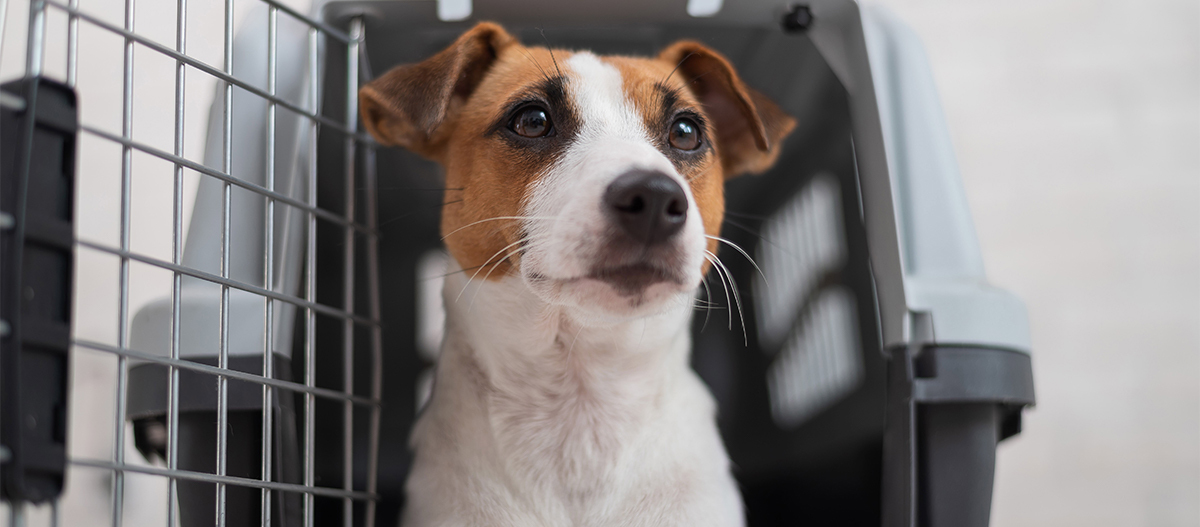Travelling with a Dog in the EU: Use Our Guide to Avoid Unpleasant Surprises
12.03.2025 - Reading time: 5 minutes

A real dog-lover doesn’t want to go on holiday without his trusty four-legged friend. But what should you know about travelling to various EU countries? We have gathered all the regulations and information you need in one guide.
- Entry into EU countries: these three things are required for dogs
- The EU pet passport: mandatory
- The microchip: an important condition for entry with a dog
- Rabies vaccination: valid from 3 weeks after the first administration
- Tapeworm treatment: which countries require this prior to entry?
- Which dog breeds can travel within the EU?
- Entry requirements with a dog in EU countries
- Visiting the vet prior to departure: why a health check is recommended
Hiking in the mountains, playing on the beach, splashing in the sea or just taking long walks in the forest – what would that be like without a dog? For many dog owners, a holiday is only half as enjoyable without their furry friend. Thankfully, the European Union harmonised the rules for entering with a dog in 2004 and simplified them in 2013. Find more information here about how you can plan for a holiday with your dog.
Entry into EU countries: these three things are required for dogs
The good news: travelling with a dog within EU countries has never been easier. EU Regulation No. 576/2013 covers the entry requirements for dogs since 2013 and applies to all EU countries.
To enter EU countries, your dog needs:
- An EU pet passport (“Blue Passport”)
- Valid rabies vaccination (at least 21 days old)
- Microchip
- Age of at least 15 weeks in certain countries (more on this below)
The EU pet passport: mandatory
The EU pet passport can only be issued by authorised vets. Before the vet can enter the necessary information and vaccinations properly into the EU passport, the animal must be chipped according to the regulations and clearly identified with the passport. This EU ID for the dog is an identification document and vaccination certificate in one. Since the EU Regulation of 2013, special care must be taken to fill this animal passport out correctly.
Parts of an EU pet passport
- Information on the owner, entered by the vet and signed by the owner
- Photo of the pet
- Vaccinations and booster vaccinations with official labelling (stickers) and validity
- Type of microchip, microchip number and barcode
- Information on location of microchip (if microchipped prior to July 2011)
- Information on labelling of dog from vet (must be laminated)
- Hand-written entry by the vet, signed and stamped
- Name and contact information of issuing vet (page IV of the pet passport)
All animal passports remain valid. In order to prevent fraud, the stickers used for vaccinations and the microchip number must be appropriately secured, e.g. via lamination or tape. The pet passport cannot “expire” or lose its validity – it is valid until the death of the animal.
The microchip: an important condition for entry with a dog
EU Regulation 576/2013 requires that dogs must be electronically labelled for clear identification. To this end, dogs must have a chip implanted under the skin on the left side of the neck. This should correspond to ISO norm 11784 or 11785, if possible. For microchips of a different ISO norm, the owner must provider a corresponding reader.
Note: If the microchip cannot be read, the dog will not be allowed to enter.

Westend61 / Westend61 via Getty Images
Rabies vaccination: valid from 3 weeks after the first administration
A rabies vaccination is necessary for entry into EU countries. This must be entered into the pet passport and – most importantly – be valid. Rabies vaccinations from some manufacturers are valid for three years.
Ensure that your dog only receives these vaccinations and that the validity has been entered correctly into your pet passport. Important to know: validity begins 21 days after the shot.
Annual rabies vaccinations have no longer been legally required since 2004 in the EU. According to the latest veterinary science from renowned international veterinary organisations, they not only have no additional value for your dog but may actually damage its health.
Do you want to travel with your very young dog outside of Europe?
Puppies can only be vaccinated against rabies from 12 weeks of age, meaning that the immunological protection, and thereby also entry into most EU countries, is only possible from 15 weeks. Exceptions from this rule apply to only a few countries, which are listed below. To find out whether there are exceptions for the entry of a puppy that is not yet vaccinated against rabies, contact the veterinary authorities or embassy of the country in question.
Where in Europe is treatment for tapeworms also required prior to entry?
No more than 5 days and no later than 24 hours prior to departure to Great Britain, Northern Ireland, Ireland, Malta, Finland and Norway, your dog must have received treatment for tapeworms from a vet. The time of day entered in your EU pet passport serves as evidence of this.
With which dog breeds can you travel within the EU?
Not all dog breeds are welcome in every European country. In France, for example, “Category 2” dogs are not granted entry. These include the American Staffordshire, Tosa and Rottweiler. For these breeds, the entry requirements are significantly restricted. If your dog is a Dobermann, Great Dane or Staffordshire Bull Terrier, entry is permitted.
Denmark is also particularly strict when it comes to allowing certain breeds to enter. Thirteen breeds are considered dangerous, which is why it is forbidden to keep, breed or enter with these dogs. This applies to all animals acquired after 17 March 2010, but also to tourists who are entering with these dogs. These breeds include the Pit Bull Terrier, the Argentinian Mastiff and the Kangal.
Owners of dogs already registered in Germany that belong to a breed that cannot be imported to Germany according to the Restriction of the Import and Transport of Dogs of 12/04/2001 are still permitted to bring their dog back after going on holiday. This includes dogs such as Pit Bull Terriers, American Staffordshire Terriers, Bull Terriers, Staffordshire Bull Terriers and their mixes.
Note: Be sure you have packed the correct documentation with you!
Entry requirements with a dog in EU countries
The entry requirements for dogs according to EU Regulation 576/2013 are binding for all EU countries. However, in some countries, exceptions to this rule are allowed due to their security laws. This applies in particular to entry regulations for certain breeds of dogs and the import of puppies. Countries are free to individually regulate the interaction between humans and dogs in public spaces and on public transportation. In order to avoid unpleasant surprises upon arrival or at the border, be sure to get an overview in advance using our comprehensive guide.

Михаил Решетников /stock.adobe.com
Entry requirements for Belgium, Bulgaria, Estonia, Italy, Lithuania, Luxembourg, the Netherlands, Austria, Poland, Portugal, Romania, Sweden, Slovakia, the Czech Republic, Hungary and Cyprus
Entry requirements for Denmark
Entry requirements for Germany
Entry requirements for Finland and Malta
Entry requirements for France
Entry requirements for Great Britain/Northern Ireland and Ireland
Entry requirements for Croatia
Entry requirements for Latvia.
Entry requirements for Slovenia
Entry requirements for Spain
Visiting the vet prior to departure: why a health check is recommended
Only a healthy dog is capable of coping with a journey, as well as the different environmental factors (new surroundings, climate, etc.). That’s why you should be sure to get a thorough health check-up for your dog from a vet before you plan a trip. You should also find out about specific animal diseases found in your destination and protect your dog from them!


